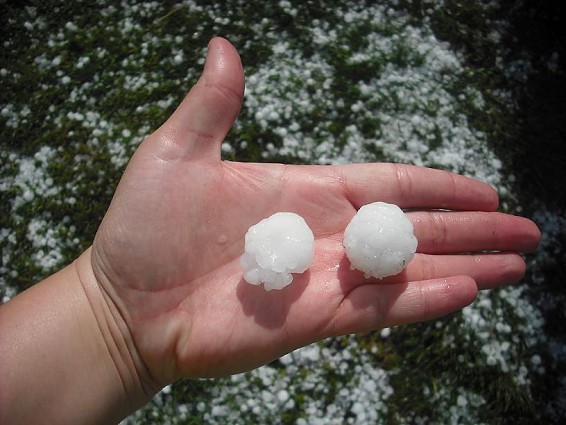Illinois State Water Survey - University of Illinois at Urbana-Champaign
State Climatologist Office for Illinois
Hail in Illinois
Dr. Jim Angel, State Climatologist

Hail is a major weather hazard in Illinois, causing damage to crops and property. Unlike temperature and precipitation, there are very few hail observations made in Illinois. Hail is very difficult to measure because it occurs very locally (requiring a high-density network) and remains in its solid form for only a few minutes before melting. The National Weather Service does report instances of hail at its primary sites in Illinois over time. These sites include Chicago, Springfield, Rockford, Peoria, Moline, and St Louis. A limited amount of information is also available from cooperative observer sites across Illinois.
Thanks to the work of Stan Changnon, a leading hail expert at the Illinois State Water Survey, numerious reports of hail in Illinois exists. Go to the ISWS publication search page and search on the keyword "hail" to see the list of 53 (!) publication on hail.
For example, a study by Changnon (1995) used NWS data to examine the limited hail records available back to 1900. Findings from that study include:
- Long-term averages vary only slightly across the state. The northern third of the state experienced about 2 days with hail per year, while the southern two-thirds experienced about 2.5 days with hail per year.
- No long-term trends were detected in the hail records.
- The period of 1946-1965 showed the highest frequency of hail days per year in the entire record.
Figure 1 shows the spatial pattern of total hail days during a 14 year period from 1981 to 1994. To get the average number of hail days per year, divide those numbers by 14. The numbers are lower, reflecting the most recent relatively quiet period.
While the long-term average occurrence of hail was about 2 to 2.5 days, some years were much more active (see Table 1).
| Station | Average | Peak |
|---|---|---|
| Chicago | 2.1 | 10 in 1947 |
| Moline | 2.3 | 9 in 1954 |
| Peoria | 2.0 | 7 in 1950, 1927, and 1954 |
| Urbana | 2.2 | 9 in 1955 |
| Springfield | 2.5 | 8 in 1975 |
| St Louis | 2.4 | 7 in 1909 |
| Marion | 2.6 | 7 in 1907, 1917, 1927, 1945, and 1970 |
From: Changnon, S. A., 1995: Temporal Fluctuations of Hail in Illinois. Illinois State Water Survey Misc. Publication 167, pp.19.